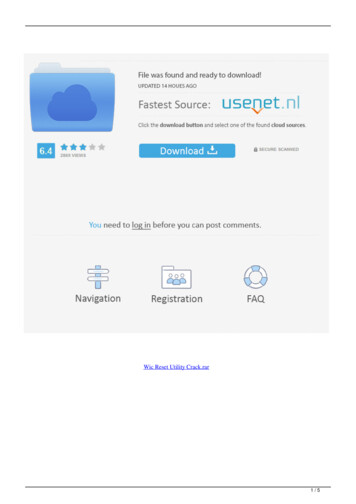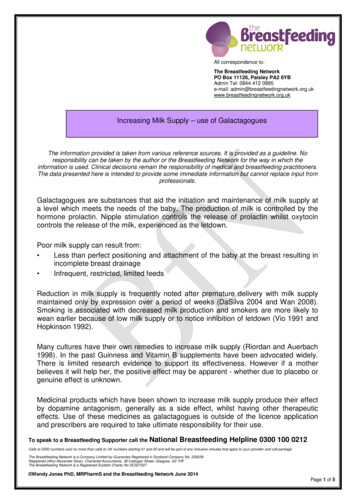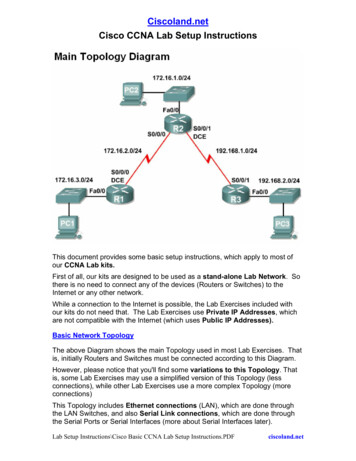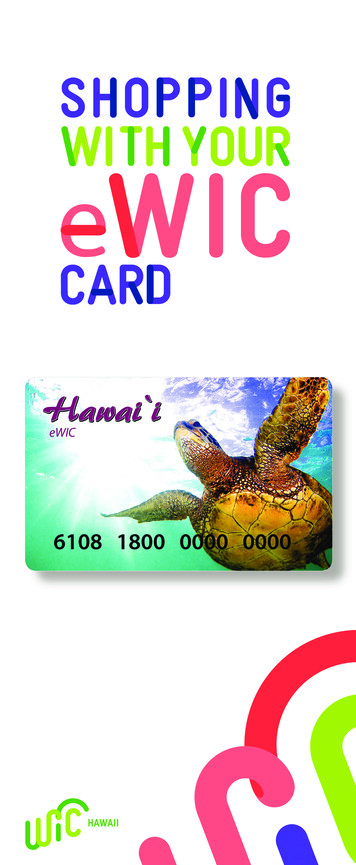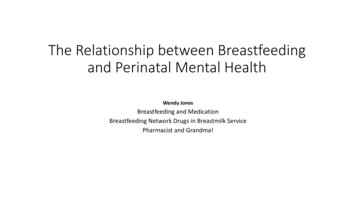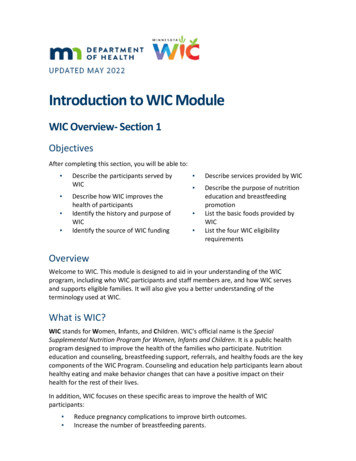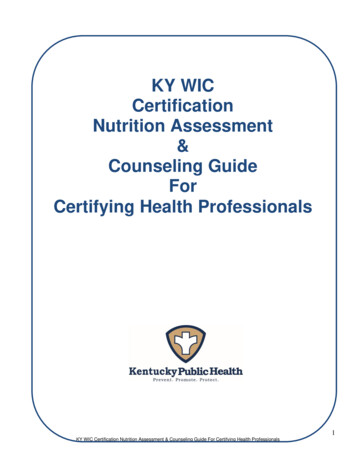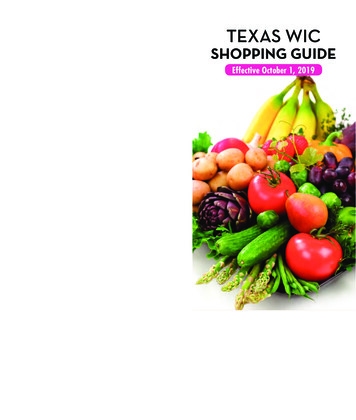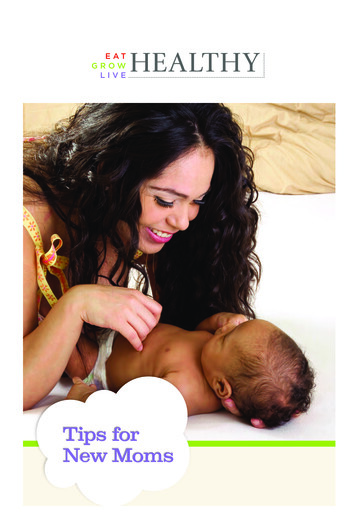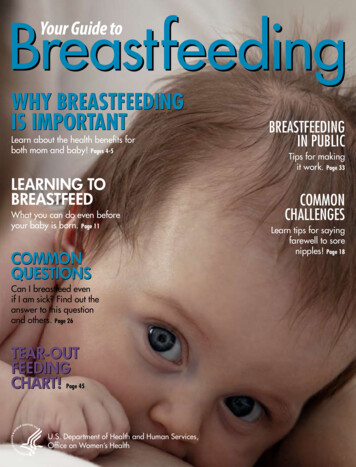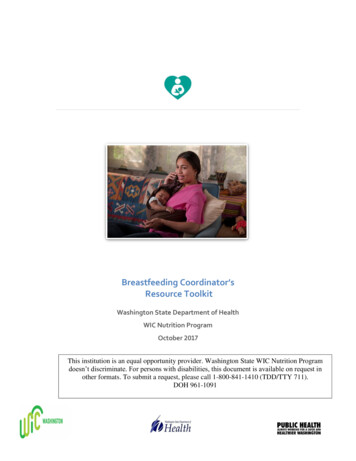
Transcription
Breastfeeding Coordinator’sResource ToolkitWashington State Department of HealthWIC Nutrition ProgramOctober 2017This institution is an equal opportunity provider. Washington State WIC Nutrition Programdoesn’t discriminate. For persons with disabilities, this document is available on request inother formats. To submit a request, please call 1-800-841-1410 (TDD/TTY 711).DOH 961-1091
Breastfeeding Coordinator’sResource Toolkit 1Welcome!Congratulations on becoming the breastfeeding coordinator for your agency or clinic. As the breastfeedingcoordinator, you’ll work with your coordinator to help set the tone for breastfeeding promotion and support inyour clinic. Your energy and passion helps keep WIC staff motivated to learn more about how to help WIC momsmeet their breastfeeding goals.The purpose of this toolkit is to help familiarize you with the role and responsibilities of breastfeedingcoordinators, and provide you with valuable information and wonderful resources. Enjoy it in good health!There’s no need to print it, just save the link to your “Favorites” for quick reference.Please let us know about your new role by asking your coordinator to contact Address Changes for clinics atWICaddress@DOH.WA.GOV with your name, role, and contact information. Once we receive this information,we’ll add you to the Local Agency Directory and the appropriate email lists.Most of the information you need to begin your journey as a breastfeeding coordinator is in the WashingtonState WIC Policy and Procedure Manual, Volume 1, Chapter 15 – Breastfeeding. Add this link to your “Favorites”for quick reference. You’ll want to read the whole chapter as time allows. Your clinic may have hard copies ofthe manuals or you can access it from the Washington State WIC policy page.WIC has promoted breastfeeding since the program’s inception in the early 1970’s. In 1989, USDA mandatedthat each state and local WIC agency have a Breastfeeding Coordinator. As the breastfeeding coordinator, you’repart of a long history of supporting breastfeeding in WIC. Feel free to learn more about the legislative history ofbreastfeeding in WIC.SS
Breastfeeding Coordinator’sResource Toolkit 2CONTENTSWelcome!1Section 1: The role and requirements of a breastfeeding coordinator6What training do I need as the breastfeeding coordinator?5What are the main duties of a breastfeeding coordinator?6Section 2: Program policy requirements7I’ve heard a lot about breastfeeding policies. Why are policies so important?7What’s the difference between a policy and a protocol?8How do I learn more about state WIC breastfeeding policies?8Where do I start?8Section 3: Your agency’s Nutrition Services Plan and Statement of Work (SOW)related to breastfeeding9What is the Nutrition Services Plan?9What’s required in the Nutrition Services Plan?10How do we evaluate our breastfeeding promotion and support objectives, and action plans?10What’s required in the breastfeeding promotion and support objectives, and our action plan?10What are the requirements related to breast pumps and supplies?11When is the Nutrition Services Plan due?11How creative can I be? I have some ideas for fun breastfeeding projects I know staff and clients will enjoy.12What’s a SOW? I know it’s not a pig!12Section 4: Required breastfeeding training for staffWhat breastfeeding training is required for WIC staff?Section 5: Breastfeeding data-what’s available and how to interpret it121214Why does WIC collect breastfeeding data?14Where does the data come from?14How do staff complete the Infant Custom Tab?15How do I get my agency’s annual breastfeeding data?17
Breastfeeding Coordinator’sResource Toolkit 3Section 6: Breastfeeding food packages in the first 30 days of life18What are the rules about breastfeeding food packages in the first 30 days of life?18How do I enroll a baby who is breastfeeding the first 30 days of life?18When do staff issue the 1 can of formula in the “Some BF 0 to 1 month” infant food package?19What if a mom needs more than 1 can of formula in the first 30 days?20What if mom comes back for formula after the first 30 days?21Infant Food Packages22The Do’s and Don’ts of breastfeeding food packages in the first 30 days of life.23Section 7: WIC breast pumpsWhat about breast pumps?2424Section 8: Purchasing breastfeeding items for your clinic25What can I buy to promote and support breastfeeding with my WIC families?25Section 9: Breastfeeding education materials26What breastfeeding education materials are available for clients and staff?Section 10: Your state office breastfeeding teamWhom can I contact with questions?232727
Breastfeeding Coordinator’sResource Toolkit 4Appendix ResourcesBreastfeeding Food Package ScenariosBreastfeeding Food Package Scenarios – AnswersFood Packages for Breastfeeding Mom and Baby in the 1st Month of LifeHelpful Words to Say to All New MothersOutcomes for Breastfeeding vs. Formula FeedingRed Flags for ClerksSample Breastfeeding ReportSolutions to Common ConcernsWIC Breastfeeding Coordinator Learning Needs Assessment – optional“The best part of being thebreastfeeding coordinator is helping mystaff get the tools they need to supportbreastfeeding families. It takes avillage to feed a child and I’m happy tobe part of that village.”
Breastfeeding Coordinator’sResource Toolkit 5
Breastfeeding Coordinator’sResource Toolkit 6Section 1: The role and requirements of a breastfeeding coordinatorWhat training do I need as the breastfeeding coordinator?To learn about the training requirements for breastfeeding coordinators, review pages 8 and 9 of Chapter 15 –Breastfeeding.If you don’t meet the requirements now, talk to your coordinator. Your coordinator can work with the stateoffice breastfeeding team to develop a training plan for you. To help start the conversation, we encourage youto complete the Breastfeeding Coordinator Learning Needs Assessment in the Appendix of this chapter. Sharethe completed form with your coordinator and send it to staff listed on the form.What are the main duties of a breastfeeding coordinator?In addition to having some breastfeeding knowledge and a willingness to learn more, the best qualification isenthusiasm and a passion for breastfeeding!The duties of the breastfeeding coordinator are to work with the coordinator to:1.Assure your agency has required written breastfeeding policies in place to meet state and localrequirements.2.Assure those policies are followed.3.Assure staff has the required initial and ongoing breastfeeding training.4.Assure your clinic is breastfeeding friendly.6.Participate in completing the breastfeeding section of the Nutrition Services Plan.7.Be the “Point of Contact” for the State WIC Breastfeeding Coordinator and other state staff for issuesrelated to breastfeeding.Talk to your coordinator about blocking out time on the schedule foryour new breastfeeding coordinator duties. It’s important to have timeset aside so you can be successful in your new role. You may need moretime before World Breastfeeding Week and before the NutritionServices Plan is due. More about these later.
Breastfeeding Coordinator’sResource Toolkit 7Depending on the size of your agency, you may want to ask about sharing the responsibilities withother staff. Other breastfeeding coordinators tell us that having another person manage the breastpump program or plan the World Breastfeeding Week activities is a big help. Sharing responsibilitieswill help you have time to revise policies or work on other projects. Working with another personoften makes the work more fun too! Talk to your coordinator about the possibility of sharing theposition or some of the duties.If your clinic has peer counselors, learn about the program requirements so you can support them andhelp your staff tap into their skills and expertise. Check out these resources: Peer Counseling Program Training checklists and toolkits on the DOH webpage.Chapter 15- Breastfeeding, page 41.Peer Counseling Loving Support Platform USB.The Loving Support Platform USB should be in your clinic. Ask your coordinator or peer counselor leadto locate it for you. If you can’t find it, contact your state office breastfeeding team. The PeerCounseling Loving Support Platform USB contains information about running a peer counselingprogram. It also contains all the resources needed to train peer counselors and other WIC staff onbreastfeeding.Source: United States Breastfeeding Committee
Breastfeeding Coordinator’sResource Toolkit 8Section 2: Program policy requirementsI’ve heard a lot about breastfeeding policies. Why are policies so important?Policies are important because they help everyone get on the same page. Good policies help “bring up” thequality of breastfeeding promotion among all staff – especially any who are reluctant to support breastfeeding.Following policies helps ensure all clients receive equally high quality services and breastfeeding support.Good policies are kind of like recipes – follow them, but don’t be afraid to think outside the box or to let yourstaff think outside the box. Don’t let a policy stop staff from going beyond what’s written to help meet the needsof your clients.If you have questions about a policy requirement, contact your state office breastfeeding team to help youproblem solve, or to ask for an exception. Our philosophy is to see how we can support you and your clients.What’s the difference between a policy and a protocol?Here at the state office we call our rules for doing things “policies”. We know that for many agencies, it’s not aneasy process to get policies approved and so they write “protocols” instead. This is fine. The main point here isto have things written down so others know what to do and how to do them. For simplicity – we use the term“policies” in this kit.How do I learn more about state WIC breastfeeding policies?The state breastfeeding policies are in Volume 1, Chapter 15–Breastfeeding of the WIC Policy Manual.Learning to become a breastfeeding coordinator is a process. Work with your coordinator to help identify whereto begin. Read pages 8 and 9 of Chapter 15-Breastfeeding to learn more about your new role.Where do I start?Take a deep breath. You don’t have to do it all at once and you don’t have to do it alone. Most likely, youragency already has breastfeeding policies or protocols in place. Becoming familiar with them is a good place tostart.As you read over them ask yourself: When was the last time your agency’s breastfeeding policies were updated?Is this what staff do now?Could we improve our policies to save staff time or serve our clients better?Are staff following the policies for tracking, issuing and cleaning pumps?If they aren’t, what are the barriers?
Breastfeeding Coordinator’sResource Toolkit 9If you can’t find your agency’s policies or protocols, ask your coordinator for help. Your state officebreastfeeding team may have copies of your clinic’s breastfeeding policies or protocols on file. We can alsoshare sample polices, if needed.Section 3: Your agency’s Nutrition Services Plan and Statement ofWork (SOW) related to breastfeedingWhat is the Nutrition Services Plan (NSP)The Nutrition Services Plan (previously called the Annual Nutrition Education Plan) is a tool agencies use inplanning their: Nutrition education activitiesFruit and vegetable nutrition education objectivesBreastfeeding promotion and support objectives, and action plansThe coordinator and nutritionist work together in developing the nutrition and fruit and vegetable sections ofthe Nutrition Services Plan.Work with your coordinator and or nutritionist to complete the breastfeeding portion of the Nutrition ServicesPlan. Breastfeeding Promotion and Support is a Core Job Responsibility in Chapter 15 – Breastfeeding, page 1.describes how the breastfeeding coordinator and the coordinator work together in developing the NutritionServices Plan.You’ll want to review the most recent Nutrition Services Plan to see what activities your agency is already doingand what resources are available to do them.When planning for next year’s Nutrition Services Plan, talk with your coordinator about the WIC budget and howmuch money you’ll need to do your activities. Creating and submitting a budget helps assure you’ll have moneyto do the breastfeeding promotion and support activities you want to do. Include funds for World BreastfeedingWeek incentives and celebrations, staff education and projects with community partners.“We meet annually to talk about what breastfeeding projects we want to do thenext year. Before we meet, my peer counselors ask their moms what we can do tobetter support them. They always have such great ideas!”
Breastfeeding Coordinator’sResource Toolkit 10What’s required in the Nutrition Services Plan?For the breastfeeding section part of the Nutrition Services Plan, three things are required.1. An evaluation of the previous year’s Nutrition Services Plan objectives and action plans.2. A report on how your agency met the contract requirements to work with community partners tosupport breastfeeding.3. An updated breast pump inventory. See more about what’s required below.The list of required activities to choose from is in your agency’s Statement of Work, (SOW) Task Number 2.2,under Breastfeeding Promotion. More about the SOW soon.How do we evaluate our breastfeeding promotion and support objectives, andaction plans?To evaluate your objectives and plans: Compare the previous year’s breastfeeding rates to the breastfeeding objectives using the breastfeedingreports in Client Services-WIC Reports. Learn more about breastfeeding data and reports in Section 5.Comment on why you think you met your objectives, or if you didn’t meet them, why not.Review your action plans and indicate if your agency completed all of your planned activities.Describe your accomplishments and any barriers you encountered.Commit to continue current activities, or change them.What do we include in our breastfeeding promotion and support objectives,and action plans?Three things are required.1. Objectives for breastfeeding initiation and duration rates for each clinic.2. At least four activities to support your breastfeeding objectives.3. How you met the requirement to work with community partners to support breastfeeding. The list ofallowable activities is in your agency’s Statement of Work, Task Number 2.2, under BreastfeedingPromotion.Every few years we send out a summary of breastfeeding projects local WIC agencies reported doing in theirNutrition Services Plan. This summary provides a wealth of great ideas to promote and support breastfeeding,including ideas for group education, connecting with community partners and so much more. Ask yourcoordinator or the state office breastfeeding team for a list of these activities.
Breastfeeding Coordinator’sResource Toolkit 11What’s required for breast pumps and supplies?There are 2 requirements for breast pumps and supplies.1. The breastfeeding equipment survey. This is a short survey about what breastfeeding related items yourclinic gives to clients.2. An inventory of all multi-user breast pumps in your clinic by serial number. Take a physical inventory ofpumps in your clinic every year to meet this requirement.We require local agencies to take a “Shelf to Sheet” multi-user breast pump inventory. A “Shelf to Sheet” is themost accurate way to take inventory.1. Take a shelf to sheet inventory by collecting the serial numbers of pumps: Physically in your clinic. Look everywhere- in storerooms, on counters, anywhere pumps can be. Loaned to clients. Do this by reviewing the Breast Pump Release ofLiability forms on file. Reported lost, stolen, and destroyed to state office staff byreviewing the Lost, Stolen or Damaged Multi-user Pump ReportsDon’t forget tosubmitted to state office staff.remove pumps2. Compare the list of these serial numbers to your master clinic inventorylist. Are there pumps on the master clinic inventory that aren’t on thenew list? Then you’ve got missing pumps. Are there pumps in your clinicthat are not on your master inventory list? Assure they belong to yourclinic and add them to your master inventory.reported to thestate office as“damaged anddestroyed” fromyour inventory.Ask your coordinator or the person managing the breast pumps for the list ofmulti-user breast pumps in your clinic. If you can’t find the multi-user breast pump serial number report, contactyour state office breastfeeding team, we may be able to help. Learn more about tracking breast pumpinventories in Chapter 15-Breastfeeding, page 35.When is the Nutrition Services Plan due?The Nutrition Services Plan is due at the end of November. We’ll send a memo to coordinators, nutritionists, andbreastfeeding coordinators with the requirements and due dates.
Breastfeeding Coordinator’sResource Toolkit 12How creative can I be? I have some ideas for fun breastfeeding projects I knowstaff and clients will enjoy.As long your agency meets the requirements, you can be as creative as you want in developing your objectivesand carrying out your action plans.What’s a SOW? I know it’s not a pig!Your agency’s Statement of Work (SOW) is a list of tasks and activities youragency has agreed to do in order to get WIC funding. Some of these items arecalled “deliverables”. Deliverables are tangible (something you can hold inyour hand) and identify what the Department of Health (DOH) and WICexpects to see from your agency. Good deliverables are evidence of the workDOH is paying your agency to do.Your agency’s SOW includes breastfeeding promotion activities. Talk with yourcoordinator about how much is budgeted from WIC Nutrition Local Support(NLS) funding for breastfeeding promotion activities this year. There are noseparate breastfeeding funds unless you budget them. Determine how muchmoney you’ll need for the coming year’s activities and work with yourcoordinator to assure this amount is reflected in your agency’s BudgetWorkbook.Section 4: Required breastfeeding trainingWhat breastfeeding training is required for WIC staff?All WIC staff providing direct client services must participate in breastfeeding training at least twice a year. Asthe breastfeeding coordinator, you’re required to complete 40 hours of lactation management training (or otherapproved training) initially and then at least 8 hours of breastfeeding training each year. See Chapter 15Breastfeeding, page 10, for staff breastfeeding training requirements. If you have questions about how to getthe training you need or what’s approved, contact the state office breastfeeding team.The Washington Department of Health, WIC Training Materials page offers many wonderful options for staffbreastfeeding and other WIC trainings. Some trainings and webinars have been moved to the LearningManagement System (LMS). If you’re not familiar with the LMS or need a password, talk to your WICcoordinator.
Breastfeeding Coordinator’sResource Toolkit 13Work with your coordinator to assure new and experienced staff alike have access to breastfeeding training thatmeets their needs and allows them to grow in their knowledge and skills. Frontline staff are your most importantresource in helping identify clients having challenges with breastfeeding. Assure they have the training andconfidence to screen moms for the common red flags of breastfeeding problems in a client centered way andnot at the front counter, if possible.There are several good staff resources in the Appendix: Red Flags for ClerksHelpful Words to Say to All New MothersSolutions to Common ConcernsBreastfeeding Food Package ScenariosBreastfeeding Food Package Scenarios- Answer SheetWorking through a few of the Breastfeeding Food Package Scenarios as a group makes for a valuable in-serviceactivity.Remember, breastfeeding is everybody’s job!For examples of roles related to promoting and support breastfeeding, see Appendix A inChapter 15-Breastfeeding.
Breastfeeding Coordinator’sResource Toolkit 14Section 5: Breastfeeding data-what’s available and how tointerpret itWhy does WIC collect breastfeeding data?Collecting breastfeeding data is important because it: Is a federal requirement.Tells our state, local and federal program staff how we are doing.Gives us an idea of how our breastfeeding promotion efforts are working.Helps policy makers make important decisions.Provides information to researchers.Helps WIC staff complete the required Nutrition Services Plan.Where does the data come from?The Breastfeeding Report collects breastfeeding initiation and duration onany infant who has turned 8 months of age during the report’s time period.Eight-month-old infants were chosen as the "denominator" because: We can see whether they breastfed at least six months. We have less of a chance of duplicate counts carried over from year toyear by looking at the infant’s date of birth.The percent initiation is counted as the number of 8-month-old infants in thereport period marked as “Currently” or “Stopped” breastfeeding divided by the number of 8 month old infantsin the report period that have the “Breastfed” field filled. Unknowns are not used when calculating initiationpercentages.An infant is included in the duration reports when either "Currently” or when "Stopped" is filled in with a dateentered in the "Date BF Stopped".Duration of breastfeeding is determined by calculating the number of weeks between the infant’s birth date andthe date entered in the “Date BF Stopped” field.If an infant's record is marked "Currently" and the "Date BF Stopped BF" is blank, the system will calculate theduration by how old the infant is in weeks.If the "Breastfed" field is initially marked as "Currently" and never updated, the infant will be counted as beingbreastfed longer than he actually had.The percent duration is given two different ways, as each way gives very different numbers in terms of publichealth planning.
Breastfeeding Coordinator’sResource Toolkit 15 The first way is the number of 8 month old infants who breastfed and have a date stoppedbreastfeeding divided by the number of 8 month old infants who ever breastfed. Calculating the datausing this method gives us more accurate information on how long women who start breastfeedingcontinue. The second way is to take the number of 8 month old infants in the report period marked as “Currently”or “Stopped” breastfeeding divided by the number of all 8 month old infants in the report periodmarked as “Currently”, “Stopped” and “Never”. Calculating the data using this method gives us theability to compare our current Washington WIC data to previous year’s data. This allows us to see trendsand track our progress.The accuracy of this data depends on how good staff are at remembering to talk with clients about howbreastfeeding is going and updating the Infant Custom Tab when a mom reports changes to their infant’sfeeding status.Here are some important facts to review with staff about how Client Services works. The “Breastfed” field on the Infant Custom Tab generates data for the breastfeeding reports, includingDay 2 Supplementation report.The “Breastfed” field on the Infant Custom Tab doesn’t determine the “Feeding Method” or the FoodPackage.The baby’s “Feeding Method” and age determines the food packages available.The baby’s food package determines the food package available for the mom.Evaluating the baby’s feeding status first makes choosing the right food packages for mom and babyeasier.Breastfeeding data is counted as missing when: “Breastfed” field is left blank.How do staff complete the Infant Custom Tab?Good question! Information collected on the Infant Custom tab generates some of our WIC breastfeeding data.To get the most accurate data: Always enter data in the “Breastfed” field on the Infant Custom Tab.o If the baby is doing any breastfeeding, select “Currently.”Don’t forget to enter the “Date BF Stopped” field when mom reports she is no longer breastfeeding.Fill in the “Date Formula/Milk Introduced” field when mom tells you.o The baby may be currently breastfeeding but has had formula.For babies who were breastfed only once, or less than one day, enter the day after the date of birth inthe “Date BF Stopped” field.For babies who received formula but who are now fully breastfeeding, enter “Currently” in the“Breastfed” field.o Enter the first day formula was given in the “Date Formula/Milk Introduced” field. Note: Thismay be the date of birth.
Breastfeeding Coordinator’sResource Toolkit 16 Enter the date anything other than breastmilk or formula is given in the “Date Solids Introduced” field.This includes adding rice cereal to a bottle.Staff often ask how to count infants who breastfed only once or less than one day.For these infants: Mark "Stopped" in the "Breastfed" field.In the "Date BF Stopped", mark one day beyond the day of birth.The infant will be counted as being breastfed " than 1 week".“Our missing breastfeeding data is zero! That’s because we have an in-service annually on theimportance of completing the Infant Custom Tab in Client Services. This helps us remember tolook at this tab when talking to moms about breastfeeding or when changing an infant foodpackage.”
Breastfeeding Coordinator’sResource Toolkit 17How do I get my agency’s annual breastfeeding data?You can access breastfeeding data in Client Services by going to WIC Reports and running the breastfeeding reportsfor your agency. There’s a sample breastfeeding report in the Appendix. If you’re the breastfeeding coordinator formore than one clinic, run the data for each clinic separately. You’ll need these reports annually for your NutritionServices Plan but you can run them anytime.There are 2 ways to track breastfeeding duration rates. You can do this by using the:1. Breastfeeding Duration of All Infants ReportOr the2. Breastfeeding Duration of Breastfed Infants Only ReportThese reports will also track your agency’s rate of missing data to see how staff are doing filling out the InfantCustom Tab. To track Fully Breastfed infants only, ask your coordinator to run your caseload management reports.Review the previous year’s Nutrition Services Plan for your clinic to see which report was used. Using the samereport every year allows you to compare the same data and more accurately evaluate changes in your clinic’sbreastfeeding rates.Every year before the Nutrition Services Plan is due; we’ll send you the Day 2 Formula Supplementation Report.Most day 2 supplementation happens in the hospital. This data can help you evaluate the level of breastfeedingsupport in hospitals where your moms deliver. If your day 2 supplementation rate is high, you may consider workingwith local hospitals as part of your community partner work.If you have questions about your agency’s breastfeeding data, talk to your coordinator, nutritionist, or state officebreastfeeding team.
Breastfeeding Coordinator’sResource Toolkit 18Section 6: Breastfeeding Food Packages in the first 30 days of lifeWhat are the rules about breastfeeding food packages in the first 30 days oflife?The rules for issuing food packages to breastfeeding moms and babies in the first 30 days of life are differentthan those afterwards. USDA tells WIC staff to enroll these babies doing any breastfeeding as “fullybreastfeeding” or “fully formula feeding”.Enroll a baby who is breastfeeding and needs formula as “fully formulafeeding.” Do a Breastfeeding Review to determine the minimum number ofcans of formula to meet the baby’s needs. Reduce the number of cans offormula before printing the infant food package. Give the least amount offormula required to meet the baby’s needs and encourage continuedbreastfeeding to help protect mom’s breastmilk production.Ask mom about her breastfeeding goals and provide support by addressingher concerns. Share with mom that more breastfeeding equals morebreastmilk, and that it’s possible to return to exclusive breastfeeding, evenafter baby has had formula.When mom comesin to enroll a babywho isbreastfeeding andtaking formula inthe first month oflife, staff mustcomplete aBreastfeedingReview.Staff must do a Breastfeeding Review before printing checks or changing thefood package for any breastfeeding infant that needs formula or an increasein formula. Learn more about The Breastfeeding Review, in Chapter 15Breastfeeding, page 12.We know this can be confusing, so we developed this Food Packages for Breastfeeding Mom and Baby in theFirst Month of Life flowsheet. Keep a copy at every work station to help staff correctly issue food packages.How do I enroll a baby who is breastfeeding the first 30 days of life?If the baby is breastfeeding and getting formula from WIC in the first month of life, staff must do a BreastfeedingReview before printing checks or changing the food package.When enrolling a baby doing any breastfeeding, staff must choose one of these infant food packages in ClientServices:1. “Formula 0 thru 3 months”Or2. “Fully BF 0 thru 5 months”
Breastfeeding Coordinator’sResource Toolkit 19If staff determines during the Breastfeeding Review that formula is needed, then a Competent ProfessionalAuthority (CPA) must: Select the Formula 0-3 food package for the infant.Reduce the number of cans of formula to meet the baby’s needs.On the Infant Custom Tab:o Select Fully Formula as the Feeding Methodo Choose “Currently” to document that she’s breastfeeding.o Enter the date formula was introduced.Support mom to meet her breastfeeding goals and offer support for a return to exclusive breastfeeding.Keep mom in the pregnant category and print Pregnant Food Package checks.Make an appointment to see mom and baby the next month to assess how breastfeeding is going andprovide continued support.When do staff issue the 1 can of formula in the “Some BF 0 to 1 month” infantfood package?The only time staff may issue the “Some BF 0
If you can't find your agency's policies or protocols, ask your coordinator for help. Your state office breastfeeding team may have copies of your clinic's breastfeeding policies or protocols on file. We can also share sample polices, if needed. Section 3: Your agency's . Nutrition Services Plan and Statement of
